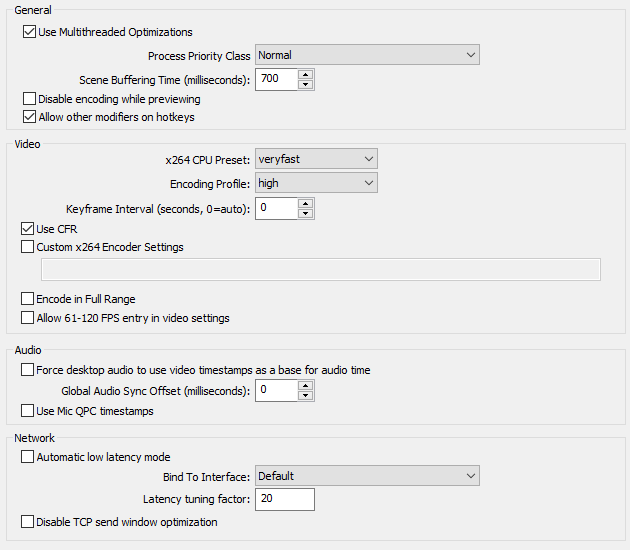Main Window
Scenes
Sources
Features
Basic Settings
Advanced Settings
FAQ
Advanced Settings

Changing advanced options should never be done unless you fully understand what you are doing. You can very easily end up with a bad quality stream, throughput problems or excessive CPU usage by changing these settings.
Use Multithreaded Optimizations
This will use multiple threads for color space conversion, maximizing benefit from multi-core CPUs. There's almost no need to ever turn this off.
- Recommended: On
Process Priority Class
Sets the process priority for OBS. As encoding can consume a lot of CPU, setting this to say "above normal" can sometimes be useful to ensure capturing and encoding is done in a more timely fashion.
- Recommended: Normal or Above Normal
Scene Buffering Time
Sets the amount of milliseconds the scene is buffered before being sent to the encoder. Only change this value if you know what you are doing. Lowering the value can lead to audio and synchronisation problems.
- Recommended: 700
Disable encoding while previewing
This setting completely de-activates the encoder while a preview is running to lower the cpu consumption.
- Recommended: Off
Allow other modifiers on hotkeys
Activates the use of several modifier keys to be used as hotkeys.
x264 CPU Preset / Quicksync Preset / Nvenc Preset
This setting determines how much CPU you want the video encoder (selected in your encoding settings) to dedicate for encoding. Settings this to a slower/lower value means the encoder will use more CPU to try to improve quality, setting this to a faster/higher will cut certain quality features in order to reduce CPU usage. Generally, the best setting is "veryfast", as it arguable gives the best tradeoff between CPU usage and quality. If you have a slower CPU or a CPU with two or fewer cores, sometimes using "superfast" and "ultrafast" are recommended in order to further reduce CPU usage, though at the cost of quality. Setting it to "faster", "fast", and below is generally not recommended and does not improve quality enough to where the increased CPU usage is justifiable.
- Recommended: veryfast
Use CFR
This will force OBS to output at a constant frame rate, duplicating frames if necessary to achieve this. This is intended to make the video files compatible with editors and decoders that don't properly support variable frame rate.
- Recommended: Off (On if editing video files)
Custom x264 Encoding Settings (also for Quicksync and Nvenc)
If you understand x264 internals, you can override any of the internal x264 parameters here. It is highly recommended that you do not paste anything that you may have found in any guides, you should almost never actually need to specify anything here. This is mainly for developers or users who understand the x264 internals.
- Recommended: None
Allow 61-120 FPS Entry
Allows you set values above 60 FPS on the Video settings. Most people only have 60 Hz screens, so going higher FPS is almost never needed and will increase encoder CPU usage. This is an advanced option for people looking to experiment only.
- Recommended: Off
Use Input device for desktop audio
This option allows you to use input(recording) devices to be used for audio input, instead of a playback device. You will not be able to capture your desktop sound while this option is active.
- Recommended: Off
Force desktop audio to use video timestamps as a base for audio time
This will construct desktop audio timestamps from the video timestamps rather than obtain timestamps directly from windows itself. This is only for the desktop audio, this is not for mic/auxiliary/webcam/device sync.
- Recommended: Off, unless you are having desktop audio sync issues (this should actually never happen anymore, if this happens email Jim immidiately)
Use Mic QPC timestamps
When activated this option tries to use the Microphone QPC timestamps to synchronize your audio and video.
Bind To Interface
If you have multiple network interfaces, select the one which you wish OBS to use.
- Recommended: Default
Latency Tuning Factor / Automatic Low Latency Mode
These are advanced options used to fine tune the "Minimize network impact" option. The effect varies depending on the network conditions. Higher value increases spacing between packets. This is a very last-resort option for precise fine tuning of packet intervals
